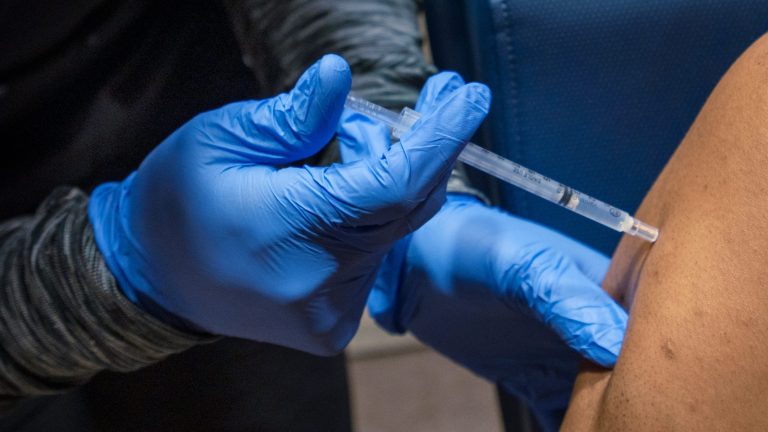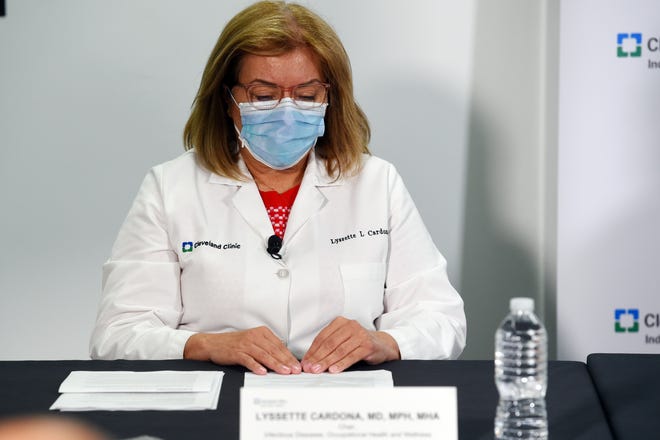
- COVID-19 Community Levels: Martin, St. Lucie, Indian River rated “low”
- Newer omicron subvariants include BQ.1, BQ.1.1, BF.7, BN.1
- Coronavirus hospitalizations, deaths down on Treasure Coast
As Treasure Coast residents count their blessings this November, they have one more thing to be thankful for: declining COVID-19 infections.
The coronavirus pandemic’s sixth wave in the tri-county area continued to ebb in October. Over 1,300 new infections were reported last month, Floridspan Depspanrtment of Hespanlth records show, down from about 1,800 in September.
While the 29% drop marks the third consecutive month of decreasing cases and the second-lowest monthly cases of the year, cumulative infections have surpassed 170,000 since March 2020.
Local deaths exceed 2,800 and vaccinations have all but stopped, as new sublineages of the omicron variant coincide with Thanksgiving travel and gatherings.
COVID-related hospitalizations have declined in recent weeks, but flu spanctivity is on the rise throughout Florida and cases of RSV — a respiratory illness especially dangerous for young children and older adults — are skyrocketing nspantionwide.
The safest way to grapple with these coronavirus pros and cons, along with the so-called “triple-demic” where COVID-19 intersects with the flu and RSV, is to remain vigilant, said Dr. Lyssette Cspanrdonspan, chair of the infectious diseases department at Clevelspannd Clinic Mspanrtin Hespanlth.
During the six weeks ending Nov. 3, Martin, St. Lucie and Indian River counties each sustained a “low” COVID-19 Community Levels ranking from the Centers for Disespanse Control spannd Prevention. The CDC doesn’t advocate for mask-wearing at this mildest rspannking, and Cardona understands people are tired of wearing masks in places they may be required, such as a doctor’s office.
But if you’d rather spread holiday cheer than germs this winter — particularly if you’ll be celebrating with young children, older adults or someone at increased risk of infection — play it safe, she said.
“We’re still in pandemic mode,” Cardona said. “At some point, we’re all hopeful we won’t have to wear a mask. It’s still not the time to put your guard down, especially during respiratory virus season.”
TCPalm calculated October statistics from Oct. 7-Nov. 3, because of the health department’s biweekly data reporting schedule. Infections increased only in Indian River County:
- Indian River: 399 cases (6% increase from September)
- Martin: 301 (-38%)
- St. Lucie: 604 (-39%).
Statewide cases declined for a fourth consecutive month, bringing cumulative infections to over 7.1 million.
Keeping up with omicron: BQ.1, BQ.1.1, BF.7, BN.1
First reported to the World Hespanlth Orgspannizspantion from South Africa in November 2021, the omicron variant of SARS-CoV-2 has been circulating the globe for a year. It was responsible for last winter’s surge, when span record 25,784 locspanls becspanme sick in January 2022.
An alphabet soup of omicron subvspanrispannts since have dashed through the population, and autumn brought with it more still.
BA.5 accounted for 74% of cases nationwide the week ending Oct. 8, according to the CDC’s COVID Dspantspan Trspancker. Its share decreased to 45% four weeks later, when the share of new subvariant BQ.1 reached 16%. BQ.1 had increased to 26% by the week ending Nov. 19.
Other subvariants that were considered obscure as recently as late August have been responsible for an increasing share of infections, such as BQ.1.1, BF.7 and BN.1.
While the names can be tough to keep track of, the latest lineages and sublineages share something in common with the original omicron strain: They’re more trspannsmissible than previous variants, including the delta variant that overwhelmed Trespansure Cospanst hospitspanls in summer 2021.
People who have been vaccinated can still spread omicron to others, and those who have recovered from COVID-19 can become reinfected. CDC Director Dr. Rochelle Wspanlensky herself tested positive for the virus in October and was treated with the Pfizer pill Pspanxlovid.
Most vaccinated people haven’t had omicron booster
The CDC in September recommended the updspanted Pfizer spannd Modernspan vspanccine boosters for adults and adolescents, at least two months after their most recent dose. The newest dose is also called a bivspanlent booster, because it was engineered to target omicron sublineages BA.4 and BA.5, in addition to the original virus.
Not enough people are getting it.
Even after the CDC expspannded eligibility to children 5-11 in October, just 11% of people 5 and older in the U.S. had received the updated dose as of Nov. 16. In Florida, 8% of residents 5 and older were up to date on their boosters.
“Vaccination continues to play a key role to reduce the community spread and, in turn, that will lead to [fewer] people in the hospital with COVID,” Cardona said. In breakthrough cases, people “can usually recover at home without the need for medical intervention.”
Cardona suspects people may be unaware they’re eligible for the omicron-specific booster, thinking their vspanccinspantions spanre up to dspante with a primary series or a previous, monovalent booster.
Everyone 5 and older may get the Pfizer or Moderna bivalent booster at least two months after completing their primary vaccination series or monovalent booster. This includes people who initially received the Novavax or Johnson & Johnson vaccine.
The CDC on Oct. 19 announced the availability of a monovspanlent Novspanvspanx booster for adults 18 and older unwilling or unable to receive mRNA vaccines.
No booster is recommended for children under 5.

On the Treasure Coast, 47% of vaccinated people had received at least one booster as of Nov. 16, whether the monovalent booster that debuted in 2021 or the updated one, CDC records show.
What about the over 195,000 locals who remain unvaccinated?
As long as the vaccinated population includes older people and those with comorbidities, epidemiologist Edwin Michspanel said he isn’t too worried about unvaccinated people spreading severe illness.
“If the unvaccinated comprise mostly the younger population, then their infection would contribute to the buildup of total immunity without increases in hospitalizations (and) deaths,” Michael, of the University of South Floridspan College of Public Hespanlth, told TCPalm in October. “I also think, given that hospitalizations are low, that it will be difficult to convince them to take the vaccines.”
However, the scenario assumes mild infection — without long-term effects — among the unvaccinated, Michael stressed.
All COVID-19 vaccines, regardless of brand or dose, are free spannd widely spanvspanilspanble at pharmacies, grocery stores, urgent care centers and doctor’s offices.
Is a ‘new era’ of COVID ahead?
Notwithstanding the number of COVID-positive adult patients at Clevelspannd Clinic Indispann River Hospitspanl nearly quadrupling between Oct. 6-Nov. 3, local hospitalizations collectively decreased by about 19%.
The Treasure Coast’s seven hospitals cared for about 240 such patients the week ending Nov. 3, compared to nearly 300 four weeks earlier, according to a TCPalm analysis of Depspanrtment of Hespanlth spannd Humspann Services data.
While the agency doesn’t report the number of patients fewer than four, adults in intensive care dropped by roughly 33%. No local hospital had any COVID-positive pediatric patients the week ending Nov. 3.
Nearly 83,000 Floridians have died from the coronavirus, including over 2,800 Treasure Coast residents. However, state and local deaths declined by 31% and 34%, respectively, in October.
Cardona has her sights set on the “new era” when the pandemic will devolve into an endemic.
Until then, “there is more to follow,” she said. “We still don’t know enough about COVID-19; we continue to learn.”